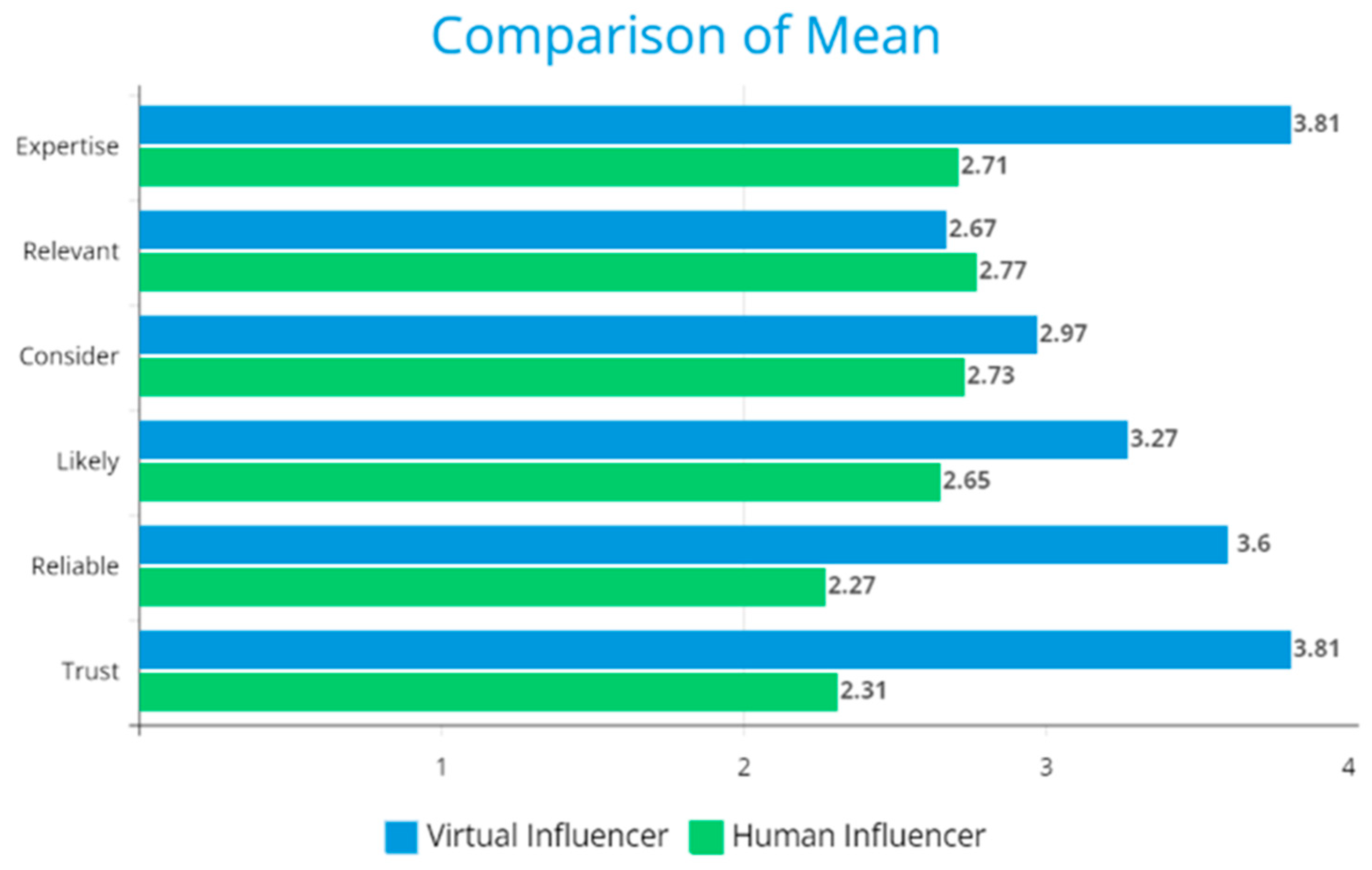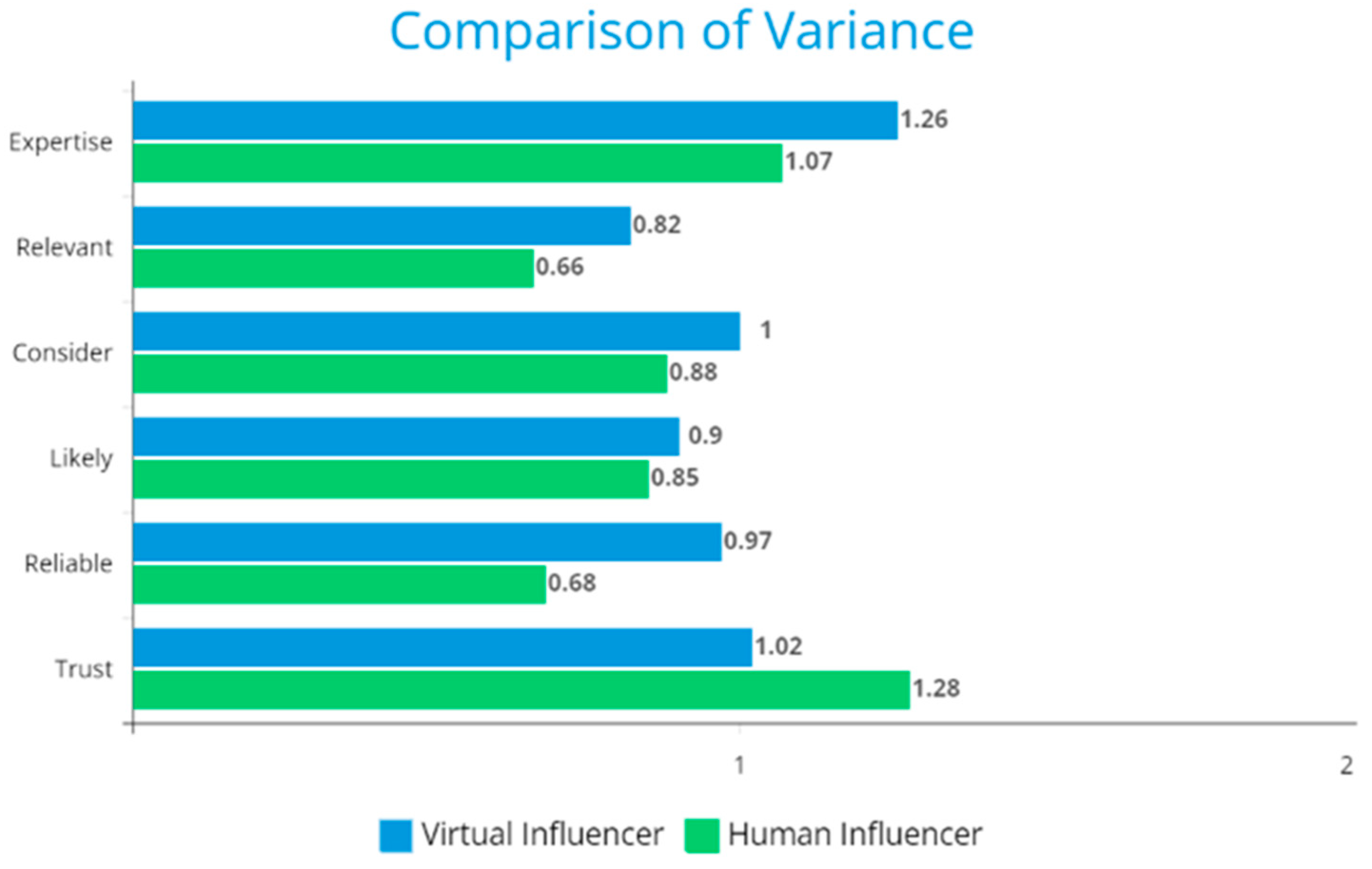To maintain the integrity and validity of the research, the questionnaire was not targeted at respondents from any particular country. The responses were received from a total of 357 participants with diverse backgrounds. It can be noted that countries such as Singapore, Japan, and the US are known for their high levels of internet and digital technology adoption. Additionally, these countries are home to some of the world’s most prestigious universities and academic institutions, which attract a large student population. Therefore, it is possible that the high response rate from these countries may be due to a combination of higher internet penetration and a higher concentration of students who are more likely to participate in online surveys.
The age of the respondents plays a critical role in analysing the responses to the questionnaire. Since virtual influencers are more popular among the millennial population, it is interesting to see the responses from millennial versus non-millennial populations. It is also essential to take the perspective of both male and female respondents towards virtual influencers to remove any gender biases. It was seen that roughly 50% of the population under scrutiny falls below the age of 45, with the other 50% comprising individuals above this age threshold. Additionally, a nearly balanced distribution of male and female respondents is observed, with 183 males and 174 females participating in the survey. Such a distribution negates the potential for bias or skewness towards a particular age or gender cohort, thereby rendering the collected data well dispersed across demographic variables.
Approximately 45% of the total respondents have attained a minimum of a graduate degree, signifying that they possess a basic understanding of consumer behaviour, preferences, and marketing concepts. Additionally, approximately 20% of respondents are high school graduates, yet belong to the millennial population who are well versed with the various social media platforms and the tactics used in social media marketing. Thus, the distribution of respondents across different education levels obviates any potential biases or skewness in the results attributable to differences in educational background.
6.2. Perceptions and Behaviour
To further understand the perception and behaviour of the respondents towards virtual influencers, an analysis was conducted on those who had no prior interaction with virtual influencers. An interaction for this study is defined as an active act of the participant, such as a comment on social media, a like, or any other activity with a virtual influencer or their accounts. Out of the 357 responses received, 124 indicated that they had no direct interaction with virtual influencers. Despite this lack of interaction, they still had perceptions about virtual influencers and their responses were based on those perceptions. The mean results of those 124 responses can be seen in
Table 3.
From the analysis, it is clear that, even though the respondents have not directly interacted with virtual influencers, they positively perceive them. This positive perception is reflected in the high mean scores of all the parameters, with some even surpassing the overall mean score. This indicates that virtual influencers are perceived positively, and these perceptions can significantly influence the customers’ trust, reliability, relevance, and expertise towards virtual influencers. Ultimately, these perceptions can impact the customers’ purchasing behaviour.
Upon a deeper analysis, it can be observed in
Table 4 that the count of strongly disagree and strongly agree responses for almost all the parameters reflects highly positive perceptions held by the respondents. This trend is consistent across the parameters of trust, reliability, likelihood of purchase, consideration of opinion, relevancy of opinion, and overall expertise.
Despite the lack of direct interaction, this phenomenon of positive perception towards virtual influencers warrants further investigation as a standalone research topic to delve deeper into customer behaviour and attitudes towards virtual influencers.
It is anticipated that the relevancy of opinion for virtual influencers will increase compared to human influencers once the engine fully synchronises with the target audience’s preferences. To verify the robustness of the findings, a chi-square independence test was conducted to assess whether the responses were associated with the sample’s demographic characteristics. The chi-square test of independence is a statistical tool that enables researchers to draw inferences about a population based on a representative sample (
Tallarida and Murray 1987). It enables the detection of associations between two variables in the population, indicating that their responses may differ across various categories such as gender, age, and location.
H0: Demographics and the theme for being influenced are not related in the population; the proportion of responses within the category is the same for all themes.
H1: Demographics and the theme for being influenced are related in the population; the proportion of responses within the category is not the same for all themes.
The results of the chi-square test for demographic segmentation of responses are tabulated in
Table 5.
As none of the p-values for the test were found to be less than 0.1, indicating that none of the values were significant at a 90% significance level, the null hypothesis cannot be rejected. Thus, it can be inferred that the responses across the population will be the same in each category, indicating that the current sample size is a reliable indicator of the population and the conducted tests are a valid representation of the overall preferences of the population. Moving forward, the next step in the methodology is to analyse variance (ANOVA), a statistical technique used to analyse the differences between two or more data groups. ANOVA tests whether the means of two or more groups are significantly different from each other. The hypotheses for the ANOVA test are:
H0: The impact of parameters such as brand trust, expertise, relevancy of the suggestions, and the consideration of suggestions is the same for all influencers on purchase intention. There is no difference in the level of impact of these parameters for virtual and human influencers.
H1: The impact of parameters such as brand trust, expertise, relevancy of the suggestions, and the consideration of suggestions is not the same for all influencers on purchase intention. There is a definite difference in the level of impact of these parameters for virtual and human influencers.
With this hypothesis in the backdrop, the ANOVA single-factor test (
Haase 1983) has been conducted in
Table 6.
As depicted in the table, the p-value for the analysis of variance between groups is close to zero, indicating a significant impact of parameters such as brand trust, expertise, relevancy of suggestions, and consideration of suggestions on overall purchase intention. Companies should prioritise developing and maintaining these parameters to gain a competitive advantage in social media marketing campaigns. Focusing on these parameters can result in successful social media marketing campaigns for companies. The empirical research shows that virtual influencers are rated higher on parameters such as trust, reliability, and expertise when compared to human influencers, and they have a greater impact on customers’ purchase intention.
The last step of the methodology is to conduct an ordinal regression. Three ordinal regressions have been carried out as a part of the analysis:
Dependent variable: consumers prefer virtual influencers over human influencers;
Independent variable: parameters of virtual influencers—trust, reliability, relevance, expertise, the likelihood of purchase, and consideration of opinion;
Control variable: age, gender, and education.
H0: The virtual influencer parameters have no impact on people’s choice of virtual influencers over human influencers.
H1: The virtual influencer parameters impact people’s choice of virtual influencers over human influencers.
Based on the results presented in
Table 7, it can be observed that the P value for model fitting parameters is 0.014, which is less than the critical value of 0.05, indicating the statistical significance of the model fitting parameters. Thus, the null hypothesis can be rejected, and it can be inferred that the independent variables, such as trust, reliability, etc., for virtual influencers significantly impact consumers’ choice of virtual influencers over human influencers. This hypothesis is further supported by the Pearson value of goodness of fit (
Table 8), which is greater than 0.05, suggesting that the data set is significant, and the independent variables contribute to the final output of the dependent variable. Moreover, the table of pseudo R-square (
Table 9) highlights the proportion of the variance explained by the independent variables on the dependent variable in the regression model. Notably, the values of these parameters are less than 0.7, indicating that the proportion of variation can be explained. Hence, this model is considered a good fit for the purpose.
Dependent variable: consumers prefer virtual influencers over human influencers;
Independent variable: parameters of virtual and human influencers—trust, reliability, relevance, expertise, the likelihood of purchase, and consideration of opinion;
Control variable: age, gender, and education.
H0: The virtual and human influencer parameters have no impact on people’s choice of virtual influencers over human influencers.
H1: The virtual and human influencer parameters impact people’s choice of virtual influencers over human influencers.
Based on the similar arguments, it can be inferred that the results (
Table 10,
Table 11 and
Table 12) are significant and, hence, the null hypothesis can be rejected.
Another regression has been performed on testing the role of virtual influencer parameters on the overall virtual-influencer-related satisfaction level of the consumers.
Dependent variable: satisfaction level of consumers with virtual influencer experience;
Independent variable: parameters of virtual influencers—trust, reliability, relevance, expertise, the likelihood of purchase, and consideration of opinion;
Control variable: age, gender, and education.
H0: The virtual influencer parameters do not impact people’s satisfaction level with virtual influencers’ experience.
H1: The virtual influencer parameters impact people’s satisfaction level with virtual influencers’ experience.
The obtained results from the conducted tests (
Table 13,
Table 14 and
Table 15) provide significant evidence to reject the null hypothesis. It can be inferred that virtual influencer parameters such as trust, reliability, relevance, and expertise have a considerable impact on consumer behaviour, leading to an increased preference for virtual influencers over human influencers. Moreover, these parameters significantly influence customer satisfaction levels following their interactions with virtual influencers. However, it should be noted that these findings are based solely on the perceptions of a small sample population, and, thus, generalization to a wider population should be performed with caution. Nevertheless, the observed trend of consumers exhibiting more trust in virtual influencers than human influencers calls for further investigation and research.







